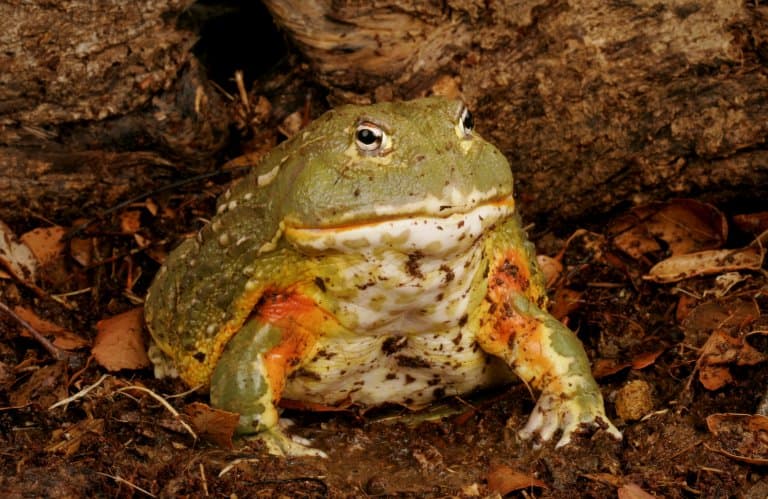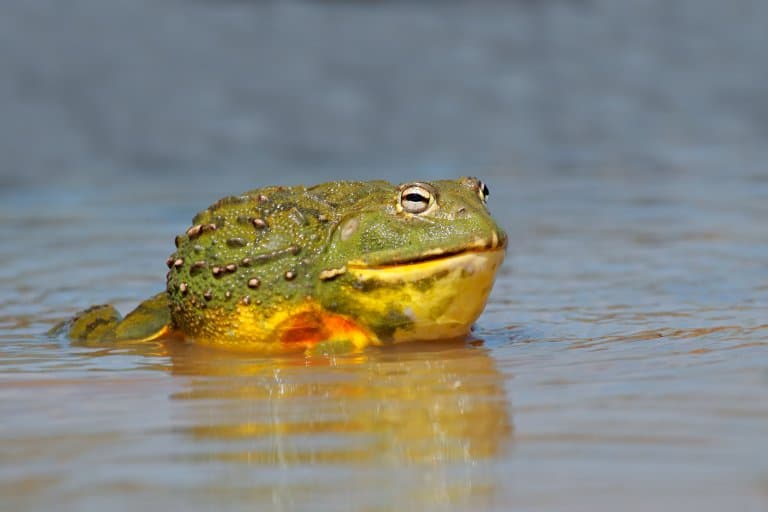African Bullfrog Profile
The African bullfrog, pyxicephalus adspersus, is a very large, carnivorous amphibian of the order anura, which comprises all frogs and toads.
They can be found in many countries in the south of the African continent, from South Africa up to Tanzania: including countries such as Malawi, Mozambique, Angola, Kenya, Uganda, the Democratic Republic of the Congo and Namibia.
The African bullfrog is actually the largest frog in southern Africa and are dull olive green in color, with a large head and ridges running down their backs. 1

African Bullfrog Facts Overview
| Habitat: | Moist savanna, scrubland, sometimes lakes, rivers, marshes and canals |
| Location: | Mainly in Southern and sub-Saharan Africa |
| Lifespan: | Up to 45 years |
| Size: | Males: up to 9 inches; females: up to 4 inches |
| Weight: | Up to 4.5lbs (males) |
| Color: | Olive/dull green, yellow/cream dewlaps |
| Diet: | Insects, other amphibians, small rodents, fish, reptiles, small birds |
| Predators: | Birds, fish, other bullfrogs (during tadpole stage), some birds of prey as adults |
| No. of Species: | 1 |
| Conservation Status: | Least concern |
The gender of African bullfrogs be distinguished by the different color of their loose hanging throats, or dewlaps. The dewlaps are yellow on males and a pale cream on females. Juvenile African bullfrogs are much more brightly coloured than the adults, often with bright yellow stripes along the ridges of their backs. 2
These coloured stripes will fade and disappear with age. They have strong back legs and short digits with little to no webbing.
They are equipped with long, fast tongues which they use to catch their prey, and three large tooth-like protuberances on their lower jaw which are used for immobilising prey once caught. They are voracious carnivores, eating insects, reptles, rodents, fish and other amphibians.
The males of the species are much larger than the females and can reach sizes of up to 10 inches in length, weighing up to a whopping 4.5lbs (over 2 kg). Females are usually around half the size of males. African bullfrogs will often spend much of their time partially buried in the ground to wait for prey.
These giant amphibians have adapted to live in many different habitats; most usually being tropical and sub-tropical scrubland, moist to dry savanna, grassland, marshes, or farmland. They are most active during wet season, and will estivate underground during the dry seasons – spending around 10 months of the year underground.
During this time, they will shed several layers of skin to create a cocoon around them, which helps to retain moisture. When the rains return and soak through the ground, this dry cocoon becomes pliable and the bullfrogs will return to ground level. It is during the rainy season that they are active and when breeding happens. 3
When breeding begins, large groups of males will congregate and will interact aggressively with one another in order to establish and defend an area of the water. Once a male has marked his spot, he will begin his whoop-like mating call to attract a female.
The female will swim underwater to the male, thus avoiding the other, smaller and less significant bullfrogs in the group, and will emerge from the water beside her chosen mate. Mating occurs in shallow water, so that the two are able to stand on the bottom, and the eggs are fertilised on the water’s surface.
The male will keep guard over his clutch of eggs until metamorphosis, exhibiting protective behaviours such as digging channels to the larger water source if the shallow water where the tadpoles are located shows signs of drying up.
Interesting African Bullfrog Facts
1. The African bullfrog is one the most adaptable amphibians on earth
Due to their adaptability, these large amphibians are able to inhabit and tolerate some of Africa’s harshest climates and even such hostile environments such as the Kalahari desert and 5,000-feet-high veld plains.
They will estivate underground during the hot or very cold seasons – this allows them to withstand dramatically changing temperatures of up to 100 degrees Fahrenheit and below freezing. 4

2. The African bullfrog is one of the largest frogs on the earth
Frogs are any of the multitude of short-bodied, tailless amphibians of the order anura and the African bullfrog also falls into this category.
They are the sixth largest in the world, behind anura, such as the cane toad and helmeted water toad. The largest anura in the world is the golilath frog of central Africa. 5
3. The African bullfrog is occasionally cannibalistic
During the breeding stage, the adult males of the species have been known to eat the eggs and tadpoles they are protecting.
Similarly, the tadpoles themselves will feed on each other and other bullfrog eggs, as well as small fish and invertebrates.

4. The African bullfrog is also known as the pixie frog or burrowing frog
Despite its huge size, the nickname pixie frog is often used to refer to the African bullfrog. However, the nickname does not actually refer to their size, and instead comes from their scientific name of pyxicephalus.
They are also known as the burrowing frog due to their strong hind legs which they use for digging themselves into the ground to wait for prey. They have a spade-like webbing on their rear feet which aids with digging. 6
5. The female African bullfrog can lay up to 4,000 eggs
The eggs are laid in shallow water and hatch into tadpoles after around 2 days. The tadpoles are heart-shaped and dark grey or black in colour.
They are ‘guarded’ by the an adult male as they grow into young frogs, which takes around 18 days. However, very few of the young frogs survive – mostly because they are eaten by adult bullfrogs.
6. African bullfrogs can be very aggressive
They will usually puff themselves up when they are angry or feel threatened, which makes them appear even larger. An African bullfrog will often attack an intruder with its body puffed up and its mouth wide open. 7
By far the most aggressive behaviours are exhibited during mating season. Large groups of males congregate at this time, and the larger bullfrogs will push, bite and chase smaller males, or even (rarely) kill and consume them! 8
7. The African bullfrog is one of only three species of frog that have ‘teeth’
It is rare to see anything resembling teeth in the mouths of anura and there are only three species that have them.
The African bullfrog uses the teeth-like protuberances in their bottom jaw to immobilise their prey once they’ve caught it; this enables them to catch and successfully kill much larger prey.
8. African bullfrogs can emit an unusual sound
This sound is a sign that the bullfrog is angry or threatened, and can be described as a roaring or bleating.

9. The African bullfrog sheds and eats its own skin
As with other species of frogs, the African bullfrog will shed its own skin in its entirety several times throughout its life. The skin will split across the back and then the belly, enabling the frog to extract its arms and legs, then head. The old skin will be consumed by the frog.
10. African bullfrogs are considered a delicacy in some places
Locals in many southern African countries regularly hunt and consume the meat of African bullfrogs.

11. African bullfrogs are threatened by habitat loss
While the African bullfrog is not a vulnerable species, they are still affected by human behaviours, including deforestation and habitat degradation.
They are also threatened from hunting and by the exotic pet trade. While their population is decreasing, they are still considered as ‘least concern’ in terms of conservation.
12. Some people keep African bullfrogs as pets
Pet owners are advised to feed their frogs with tongs in order to protect their hands, as the bullfrogs can jump high and may consider their handlers fingers a tasty treat!

African Bullfrog Fact-File Summary
Scientific Classification
| Kingdom: | Animalia |
| Phylum: | Chordata |
| Class: | Amphibia |
| Order: | Anura |
| Family: | Pyxicephalidae |
| Genus: | Pyxicephalus |
| Species Name: | Pyxicephalus Adspersus |
Fact Sources & References
- “African bullfrog”, Oregon Zoo.
- Christal Pollock (2011), “Basic Information Sheet: Giant African Bullfrog”, Lafeber Vet.
- Benjamin Davidson, “Pyxicephalus adspersus”, Animal Diversity.
- “African bullfrog”, Elmwood Park.
- “African bullfrog”, London Zoo.
- “African bullfrog”, Kids Britannica.
- “African bullfrog”, Virginia Zoo.
- Andy Jeffrey (2016), “Watch: Huge African bullfrog shows off its ambush hunting skills”, Earth Touch News Network.
